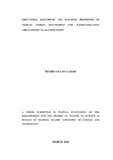STRUCTURAL, ELECTRONIC AND MAGNETIC PROPERTIES OF NIOBIUM NITRIDE POLYMORPHS FOR SUPERCONDUCTING APPLICATIONS:
Abstract
The quest for a hard superconducting material with engineering applications has been going on for some time. Among the hard superconducting materials is Niobium Nitride which superconducts at 17 K. Niobium nitride has excellent mechanical properties required for engineering applications and therefore has been the focus of research in the recent past. It has four structural polymorphs, that is, b1, b4, b81 and bh. Current research that has been done on this material has been skewed towards b1 and b81 leaving out the other two. In this work, Investigation basing on first principles on structural, electronic and magnetic properties for b1, b4, b81 and bh polymorphs was carried out. Comparison of the structural, electronic and magnetic propeties of the four polymorphs will help to assess the suitability of each polymorph for superconducting applications. In this work, calculations were performed using density functional formalism as implemented in the Quantum ESPRESSO computer code with the exchange-correlation functional in the local density approximation. Ultrasoft pseudopotentials was used to describe the electron- ion interactions. Initially, the optimized lattice parameters were obtained by fitting the total energy versus volume data to the Murnaghan equation of state. The structure was then relaxed until all the components of force on each atom was less than 10-3 Ry per a.u. The investigation reveals that b81 is the most stable with the least energy vs volume per formula unit. Phase transition is observed when pressure is exerted on the structures, with b81 transiting to b4 and b1 to bh. The four polymorphs have negative enthalpy indicating their possibility in synthesis. The density of states, band structures and charge density confirm that the polymorphs are metallic, good conductors, bonding is covalent and metallic. They are all found to be non-magnetic at zero K. Comparatively;bh stands out with the best qualities for superconductivity applications like making of superconducting wires, motors, magnetic recorders, Infra-red sensors and radio frequency superconducting accelerator cavities.

